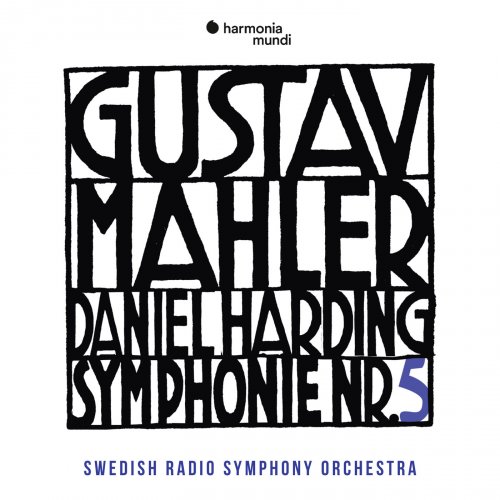Swedish Radio Symphony Orchestra & Daniel Harding - Mahler: Symphony No. 5 (2018) [Hi-Res]

Artist: Swedish Radio Symphony Orchestra & Daniel Harding
Title: Mahler: Symphony No. 5
Year Of Release: 2018
Label: harmonia mundi
Genre: Classical
Quality: FLAC (tracks) / 24bit-48kHz FLAC (tracks+booklet)
Total Time: 01:13:20
Total Size: 300 / 714 MB
WebSite: Album Preview
Tracklist:Title: Mahler: Symphony No. 5
Year Of Release: 2018
Label: harmonia mundi
Genre: Classical
Quality: FLAC (tracks) / 24bit-48kHz FLAC (tracks+booklet)
Total Time: 01:13:20
Total Size: 300 / 714 MB
WebSite: Album Preview
1. Symphony No. 5, Part. I: 1. Trauermarsch. In gemessenem Schritt. Streng. Wie ein Kondukt 14:07
2. Symphony No. 5, Part. I: 2. Stürmisch bewegt. Mit größter Vehemenz 15:27
3. Symphony No. 5, Part. II: 3. Scherzo. Kräftig, nicht zu schnell 18:22
4. Symphony No. 5, Part. III: 4. Adagietto. Sehr langsam 10:28
5. Symphony No. 5, Part. III: 5. Rondo-Finale. Allegro - Allegro giocoso. Frisch 14:56
As the last completed symphony that Mahler wrote, the Ninth has often been heard by audiences as the composer’s swan song: a nostalgic, moving farewell from a composer conscious of his own mortality. This interpretation is of course easily justifiable, as etched into the musical fabric of the symphony are references to the tragedies that befell the composer in the years before his death. Furthermore, it is wholly plausible that for a man as melodramatic as Mahler, the idea of a symphony that centres around themes of loss and finality would surely have been an appealing prospect.
Nonetheless, although the symphony certainly has its fair share of poignant and contemplative moments, it is much more than just a musical epitaph. Indeed, one should bear in mind that when the Ninth was written, Mahler was already preparing for various conducting commitments in the USA, and began work on the Tenth soon after the Ninth was completed. This was not a composer on the cusp of death.
Composed over two summers at the composer’s Alpine retreat in Toblach (now Dobbiaco) between 1908 and 1909, the Ninth was written in the wake of several life-changing events for Mahler. In 1907, his eldest daughter Maria Anna died from scarlet fever at only 4 years old, and soon after Mahler was diagnosed with the heart condition which would ultimately kill him come 1911. Furthermore, in the same year Mahler resigned from his position as the director of the Vienna Court Opera, a role he had cherished during his tenure despite mounting criticism. For a composer who so consistently composed the world around him into his symphonies, it is no surprise that references to these events found their way into the Ninth, and arguably imbue the drama of the first and last movements in particular with an additional degree of poignancy. The symphony opens tentatively, with a stuttering rhythmic motif which might easily be heard as a depiction of the composer’s failing heart, and, four movements later, closes with a ‘dying away’ (ersterbend) chord of Db major which teeters on the edge between sound and silence, love and loss, life and death. The poetic narrative between these two events encompasses many of the tropes of Mahler’s late style, as well as an array of subtle references to his life and world in these troubled years.
"While Gustav Mahler's Symphony No. 9 in D major was his last completed symphony and came to be regarded as his farewell to life (notwithstanding the substantial effort he put into writing his unfinished Symphony No. 10 in F sharp major, which wasn't heard in a complete performing version until the 1960s), there is a case to be made for this penultimate symphony as a climactic engagement with the forces of existence, rather than as a last will and testament. Daniel Harding and the Swedish Radio Symphony Orchestra deliver a powerful reading that contends with Mahler's characteristic themes of death, fate, conflict, and reconciliation, which are all familiar from the earlier symphonies; yet they give the Ninth a muscular vigor and visceral excitement that seem to balance, if not wholly override, the morbidity of the first movement and the ecstasy of the finale. This is music of an internal struggle, and Harding emphasizes the tension that grows out of Mahler's increasingly dissonant counterpoint and driving rhythms, chiefly in the bumptious, Ländler-based Scherzo and the sardonic Rondo-Burleske, the intensely active inner movements suggesting that Mahler's state of mind was far from final things. Harmonia Mundi's sound has a wide dynamic range, so the softest passages in the outer movements may require some adjustment of the volume, though most of the performance is fully audible at a comfortable mid-level." (Blair Sanderson, AMG)
Swedish Radio Symphony Orchestra
Daniel Harding, Dirigent
Nonetheless, although the symphony certainly has its fair share of poignant and contemplative moments, it is much more than just a musical epitaph. Indeed, one should bear in mind that when the Ninth was written, Mahler was already preparing for various conducting commitments in the USA, and began work on the Tenth soon after the Ninth was completed. This was not a composer on the cusp of death.
Composed over two summers at the composer’s Alpine retreat in Toblach (now Dobbiaco) between 1908 and 1909, the Ninth was written in the wake of several life-changing events for Mahler. In 1907, his eldest daughter Maria Anna died from scarlet fever at only 4 years old, and soon after Mahler was diagnosed with the heart condition which would ultimately kill him come 1911. Furthermore, in the same year Mahler resigned from his position as the director of the Vienna Court Opera, a role he had cherished during his tenure despite mounting criticism. For a composer who so consistently composed the world around him into his symphonies, it is no surprise that references to these events found their way into the Ninth, and arguably imbue the drama of the first and last movements in particular with an additional degree of poignancy. The symphony opens tentatively, with a stuttering rhythmic motif which might easily be heard as a depiction of the composer’s failing heart, and, four movements later, closes with a ‘dying away’ (ersterbend) chord of Db major which teeters on the edge between sound and silence, love and loss, life and death. The poetic narrative between these two events encompasses many of the tropes of Mahler’s late style, as well as an array of subtle references to his life and world in these troubled years.
"While Gustav Mahler's Symphony No. 9 in D major was his last completed symphony and came to be regarded as his farewell to life (notwithstanding the substantial effort he put into writing his unfinished Symphony No. 10 in F sharp major, which wasn't heard in a complete performing version until the 1960s), there is a case to be made for this penultimate symphony as a climactic engagement with the forces of existence, rather than as a last will and testament. Daniel Harding and the Swedish Radio Symphony Orchestra deliver a powerful reading that contends with Mahler's characteristic themes of death, fate, conflict, and reconciliation, which are all familiar from the earlier symphonies; yet they give the Ninth a muscular vigor and visceral excitement that seem to balance, if not wholly override, the morbidity of the first movement and the ecstasy of the finale. This is music of an internal struggle, and Harding emphasizes the tension that grows out of Mahler's increasingly dissonant counterpoint and driving rhythms, chiefly in the bumptious, Ländler-based Scherzo and the sardonic Rondo-Burleske, the intensely active inner movements suggesting that Mahler's state of mind was far from final things. Harmonia Mundi's sound has a wide dynamic range, so the softest passages in the outer movements may require some adjustment of the volume, though most of the performance is fully audible at a comfortable mid-level." (Blair Sanderson, AMG)
Swedish Radio Symphony Orchestra
Daniel Harding, Dirigent
Download Link Isra.Cloud>>>
Mahler_Symphony_No_5_Hi-Res.rar - 715.0 MB
Mahler_Symphony_No_5.rar - 300.8 MB
Mahler_Symphony_No_5_Hi-Res.rar - 715.0 MB
Mahler_Symphony_No_5.rar - 300.8 MB



![Zbigniew Namyslowski Modern Jazz Quartet - Lola (Remastered 2025) (2025) [Hi-Res] Zbigniew Namyslowski Modern Jazz Quartet - Lola (Remastered 2025) (2025) [Hi-Res]](https://www.dibpic.com/uploads/posts/2025-12/1765509687_cover.jpg)



![Chris Connor - Free Spirits (Remastered) (2025) [Hi-Res] Chris Connor - Free Spirits (Remastered) (2025) [Hi-Res]](https://www.dibpic.com/uploads/posts/2025-12/1765538301_ccfs500.jpg)
